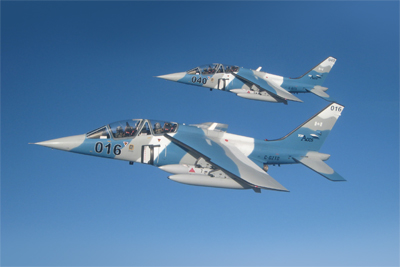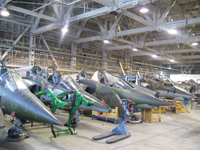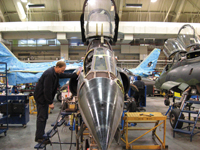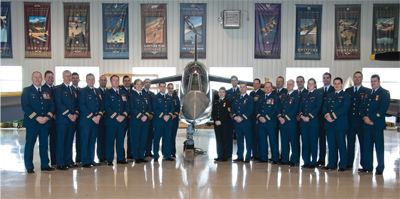
Features
Safety
Sparring Partners To The Forces
No matter how advanced the simulator, nothing trains fighter pilots better than going up against ‘aggressor aircraft.’
April 14, 2010 By JAMES CARELESS
No matter how advanced the simulator, nothing trains fighter pilots better than going up against ‘aggressor aircraft.’ These are actual jet fighters flown by experienced pilots – unarmed for safety, but carrying electronic countermeasures – which challenge the trainees in the air, forcing them to put their ground-based training to the test.
 |
| The Top Aces fleet includes 16 ex-military Dassault-Breguet-Dornier Alpha Jets.
|
Most militaries operate their own ‘aggressor squadrons’ as part of their training regimes. But in Canada, our aggressor squadron is a privately-owned venture run by three former CF-18 fighter jocks. Known as Top Aces (now a wholly-owned subsidiary of Discovery Air), this company has its own fleet of 16 ex-military Dassault-Breguet-Dornier Alpha Jets, supplemented by four twin-jet Westwind 1124s for carrying electronic warfare equipment and towing target arrays.
“We serve as the Canadian Forces’ aerial sparring partner,” says Garry Venman, Top Aces’ VP of Business Development. “We give their CF-18 pilots the kind of aggressor aircraft training they need, at no capital cost to the Canadian government and the requirement to only pay for the training they use.”
The birth of Top Aces’ air force
Top Aces was founded in 2000 by Paul Bouchard, Dave Jennings and Didier Toussaint. All three were former military CF-18 pilots. Each had graduated from Canada’s highly-selective ‘Top Gun’ program, which is blandly referred to as the Fighter Weapons Instructor Course.
 |
| Top Aces aircraft are based at CF training facilities at Cold Lake, Alta., Bagotville, Que., Victoria, B.C., and Halifax, N.S.
|
Initially, Top Aces began as an aerospace consulting firm in Pointe-Claire, Que. (part of Montreal). But the Canadian Forces’ decision to disband its own aggressor squadron as a cost-saving measure opened up an opportunity to venture into training. The result: In 2005, Top Aces was the lowest bidder on a five-year CF training contract, beating out Bombardier and three other bigger, better-funded competitors. At press time, the Government of Canada had just exercised an option to extend Top Aces services until 2011. Also, recently announced, Top Aces is continuing its review of the Government of Canada’s procurement plan for airborne training services beyond 2011 under a proposed new 20-year long term contract (10 years with two 5-year Government of Canada options) for both Type 1 (fast jet) and Type 2 services.
Today, Top Aces’ aircraft are based at CF training facilities at Cold Lake, Alta., Bagotville, Que., Victoria, B.C., and Halifax, N.S. In addition to providing CF-18 pilots with aggressor aircraft to fly against, Top Aces’ Alpha Jets fly mock attacks on CF navy ships. On the flip side, these same jets act as ‘friendlies’ for the CF Army, allowing their Forward Air Controllers to train with aircraft before shipping out to Afghanistan.
“Our job is to support the training efforts of the Canadian Forces, while saving them the expense of owning, operating and manning the aircraft,” Venman tells Wings magazine. “In doing so, the Canadian Forces saves millions on equipment costs, and is able to redeploy its personnel to other work.” In support of this mission, which is executed with close CF supervision, Top Aces has its own maintenance and repair shops.
Top-notch capabilities
Despite their military heritage, none of Top Aces’ Alpha Jets are capable of actual military warfare. “All of their weapons and weapons systems are either removed or disabled before we get them,” says Venman. “The governments we obtain these aircraft from, such as the Germans who used Alpha Jets as Light Strike aircraft from the late 1970s through 1990s, will not export them unless they have been demilitarized. The Canadian government is similarly vigilant about such imports, as are the Americans. Since the Alpha Jets incorporate some U.S. military technology, we have to get U.S. State Department approval to use them, which can be quite a challenge.”
 |
| The Alpha Jets are capable of 550 kts (0.95 Mach) and are powered by two SNECMA/Turbomeca Larzac 04-C6 turbofan engines.
|
The Dassault-Breguet-Dornier Alpha Jets flown by Top Aces are subsonic models, capable of a top speed of 550 kts (0.95 Mach). They are powered by two SNECMA/Turbomeca Larzac 04-C6 turbofans that can deliver a combined thrust of 5,952 pounds. The Alpha Jets are two-seaters, with the Top Aces pilot in the front and a CF electronics warfare specialist in the back. (The EW specialists belong to the CF’s newly-revived 414 Squadron, which is based in Ottawa.) They have a ceiling of 50,000 feet, carry jamming/chaff/ACMI pods, threat simulators and AAG Target Tows, and have a range of 1,000 nautical miles when equipped with external fuel tanks.
“The Alpha Jet’s performance is akin to that of a BAE Systems Hawk,” Venman notes. “It is superior to the TC-133 Silver Stars that the CF had in its aggressor squadron.” Very true: The 1950s’ vintage TC-133’s top speed was 515 knots and its operational ceiling was 47,000 feet. The only situation in which a CF-18 pilot would be likely to encounter a TC-133 (a.k.a. the Lockheed T-33 Shooting Star) or an adversary aircraft of similar capabilities would be at an air show. In terms of real-life training, the TC-133 is just too dated for military use. In fact, trainer versions of the Alpha Jet replaced T-33A trainers used by the French and West German air forces.
Rookies need not apply
Fighter jocks are known for their take-no-prisoners approach to life. This is useful for the military, who need pilots determined to dominate the skies. But it is not the sort of characteristic that Top Aces needs in its pilots; all of whom are experienced, retired CF-18 officers.
“In a training situation, aggressor pilots have to be able to back off whenever necessary, and to stay within the limits that the instructors impose on them,” Venman explains. “The last thing you need is them flying with their egos out front, doing their best to dominate the students. This is why we only hire retired CF-18 pilots who have proven their maturity in the cockpit. These are guys who have done their 20 years and have nothing left to prove, unlike the students they are challenging. We can trust them to keep the flight exercises safe yet effective – and to bring themselves and the aircraft safely back to Earth.”
Moving to Top Aces after retiring from the Canadian Forces is a welcome option for many CF-18 pilots. Before the company came along, their best bet was to go to Air Canada, a career path that company founders Bouchard, Jennings and Toussaint took and then rejected for more exciting work.
Challenges and opportunities
It only took Top Aces six months to begin flying aggressor flights for the Canadian Forces, after winning its contract in 2005. The initial Alpha Jet fleet was brought in from the United States. Further aircraft have since been purchased from Germany and other countries.
 |
| Squadron 414 with Alpha Jet.
|
Even with this success, obtaining new aircraft remains a constant headache. “It is just not easy to find and then import former jet fighters,” Venman says. “When we do, there’s a lot of paperwork to be done – after ensuring that the aircraft is still flightworthy and maintainable.”
The second challenge is pilots: To date, Top Aces has stuck with former CF-18 pilots for its trainers, because of their in-depth knowledge of fighter operations and the ways in which the Canadian Forces work. However, there are not that many pilots retiring from the Forces each year, and those that do aren’t always interested in continuing the fighter jock life. “Because the quality of our pilots is paramount, we have to find them first and then figure out how to get them where we need them to be,” he notes. “This means that we fly them in from wherever they live to wherever we need them to be. Not everybody wants to keep living in Cold Lake after they’ve retired.”
As for the future? Top Aces’ success in fulfilling its CF contract opens up new opportunities. “We can foresee providing similar aggressor aircraft services in the U.S. and Europe,” Venman notes. “Of course, we would have to jump through a lot of hurdles to do so. Still, very few people believed that a private company could provide aggressor aircraft support to the Canadian Forces back in 2005, and we have made that happen. So I see no reason why we couldn’t meet the challenge of going
international.”
| Dassault-Breguet-Dornier Alpha Jet Heritage Dassault-Breguet-Dornier’s Alpha Jet was developed as a subsonic trainer and light attack aircraft by the French and West German governments in 1970. Four prototypes of this twin-engine, cantilever shoulder-wing two-seater were built, followed by the onset of full production. The French built 200 Alpha Jet Es (Ecole) as trainers, while the West Germans built 176 Alpha Jet As (mounted with a pointed nose, as opposed to the Alpha Jet E’s blunt nose) for light strike deployments. More than 500 Alpha Jets were built into the 1980s. According to The Encyclopedia of World Aircraft (Orbis Publishing, 1997), Belgium purchased 33, Cameroon 7, Egypt 45, Ivory Coast 7, Morocco 24, Nigeria 24, Qatar 6 and Togo 5. Besides the A and E versions, this aircraft was also built as the Alpha Jet 2 with new avionics, a head-up display, inertial navigation system and a laser rangefinder; and finally as the Alpha Jet 3 ATS (Advanced Training System/Advanced Tactical Support). “Evolved from the Alpha Jet 2, the Larzac 04-C20 powered Alpha Jet 3 ATS is effectively a flying simulator equipped to lead pilots into new advanced combat aircraft such as the Mirage 2000, Rafale, Gripen and F-16.” |